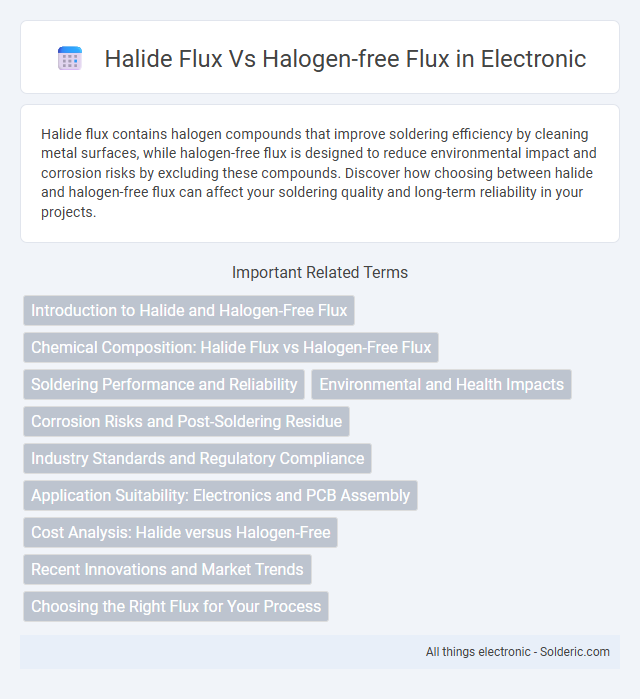Halide flux contains halogen compounds that improve soldering efficiency by cleaning metal surfaces, while halogen-free flux is designed to reduce environmental impact and corrosion risks by excluding these compounds. Discover how choosing between halide and halogen-free flux can affect your soldering quality and long-term reliability in your projects.
Comparison Table
| Feature | Halide Flux | Halogen-Free Flux |
|---|---|---|
| Composition | Contains halide compounds (chlorides, bromides) | Free of halogens; typically organic acids and activators |
| Corrosiveness | High; residue can be corrosive if not cleaned | Low; designed to minimize corrosion risks |
| Cleaning Requirements | Requires thorough cleaning to remove corrosive residues | Often no-clean or minimal cleaning needed |
| Environmental Impact | Potentially harmful due to halogen content | More eco-friendly; aligns with RoHS and environmental standards |
| Activation Performance | Strong activation for soldering difficult metals | Moderate activation; may require process adjustments |
| Typical Applications | Used in electronics requiring high reliability with post-cleaning | Widely used in lead-free soldering and environmentally sensitive applications |
| Residue | Often corrosive and conductive if left uncleaned | Non-corrosive, non-conductive residues |
Introduction to Halide and Halogen-Free Flux
Halide flux contains active halogen elements like chlorine, bromine, or iodine, enhancing soldering by promoting oxide removal and improving wetting on metal surfaces. Halogen-free flux eliminates these halogens to reduce corrosive residues and environmental impact, making it suitable for sensitive electronics and lead-free soldering applications. Your choice between halide and halogen-free flux depends on balancing soldering performance with environmental and safety considerations.
Chemical Composition: Halide Flux vs Halogen-Free Flux
Halide flux contains chemical compounds such as chlorides, bromides, or iodides that enhance soldering by promoting oxide removal on metal surfaces. Halogen-free flux, by contrast, is formulated without halogen elements, using organic acids or synthetic chemicals to reduce environmental and health hazards. Understanding your application's chemical composition requirements helps optimize soldering performance while minimizing corrosion risks associated with halide residues.
Soldering Performance and Reliability
Halide flux contains aggressive halide salts that significantly enhance solder wetting and activator efficiency, resulting in superior soldering performance on oxidized or difficult-to-solder surfaces. Halogen-free flux formulations prioritize environmental and health safety, offering moderate soldering effectiveness but generally providing improved long-term reliability and reduced corrosion risk on sensitive electronic components. Your choice between halide and halogen-free flux should balance immediate solder joint quality with long-term device performance and compliance with regulatory standards.
Environmental and Health Impacts
Halide flux contains reactive halogen compounds that can release toxic gases and corrosive residues during soldering, posing significant environmental and health risks. In contrast, halogen-free flux minimizes the release of harmful substances, reducing air and water pollution and lowering occupational exposure to irritants and carcinogens. The adoption of halogen-free flux supports compliance with stringent environmental regulations such as RoHS and WEEE, enhancing workplace safety and sustainability.
Corrosion Risks and Post-Soldering Residue
Halide flux contains active halide ions like chloride and bromide, which significantly increase the risk of corrosion and conductive residue on circuit boards if not thoroughly cleaned after soldering. Halogen-free fluxes eliminate these aggressive halides, resulting in lower corrosion potential and minimal post-soldering residue, enhancing long-term reliability of electronic assemblies. Selecting halogen-free flux is critical for sensitive applications requiring stringent residue control and corrosion resistance.
Industry Standards and Regulatory Compliance
Halide flux contains halogen compounds such as chlorine and bromine, which deliver excellent soldering performance but often fail to meet stringent environmental standards like RoHS and REACH due to their corrosive and toxic nature. Halogen-free flux formulations comply with industry standards by reducing hazardous substances, aligning with regulatory requirements to minimize environmental impact and ensure workplace safety. Manufacturers increasingly adopt halogen-free flux to certify products for global markets while maintaining effective solder joint reliability in electronics assembly.
Application Suitability: Electronics and PCB Assembly
Halide flux is highly effective for electronics and PCB assembly due to its superior ability to remove oxides and enhance solder joint reliability, making it ideal for applications requiring strong electrical connections. Halogen-free flux offers a safer, environmentally friendly option with reduced corrosive residues, suitable for sensitive electronics and compliance with regulatory standards. Your choice should balance performance requirements with safety and environmental considerations to ensure optimal assembly results.
Cost Analysis: Halide versus Halogen-Free
Halide flux typically offers lower initial cost due to its widespread availability and effective cleaning properties, making it a popular choice in electronic assembly. Halogen-free flux, while generally more expensive upfront, reduces environmental compliance costs and minimizes expensive corrosion damage in sensitive applications. The total cost analysis often favors halogen-free flux for long-term reliability and regulatory advantages despite its higher price point.
Recent Innovations and Market Trends
Recent innovations in halide flux formulations emphasize enhanced solder joint reliability and reduced corrosiveness, driven by the demand for high-performance electronics in automotive and aerospace industries. Halogen-free fluxes showcase increasing adoption due to stricter environmental regulations and consumer preference for eco-friendly materials, leading to advancements in bio-based and non-toxic chemistries. Market trends indicate a growing shift towards halogen-free fluxes in Asia-Pacific, driven by rapid electronics manufacturing growth and government policies promoting sustainable production.
Choosing the Right Flux for Your Process
Halide flux contains reactive halogens that enhance soldering by removing oxides and promoting excellent wetting, ideal for challenging surfaces and high-reliability applications. Halogen-free fluxes offer a safer, eco-friendly alternative with reduced corrosion risk and compliance with environmental regulations, suitable for sensitive electronics and consumer products. Evaluating your process requirements, equipment compatibility, and environmental standards ensures you select the optimal flux that balances performance and sustainability.
Halide flux vs halogen-free flux Infographic

 solderic.com
solderic.com